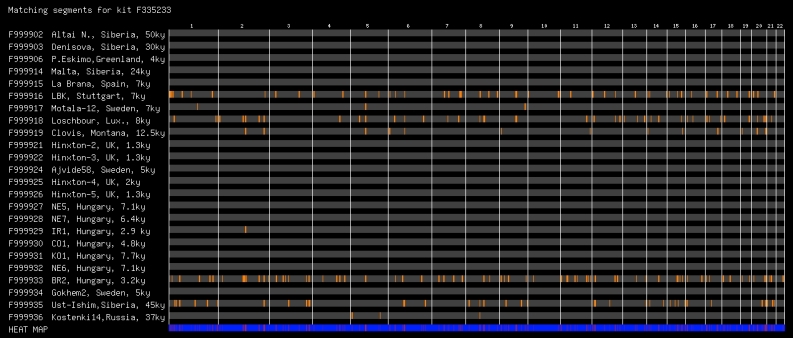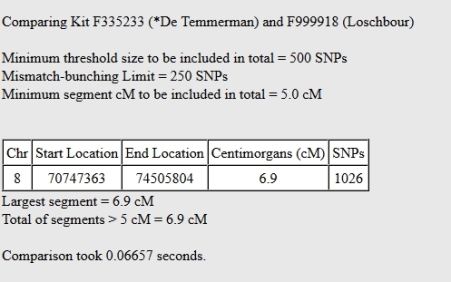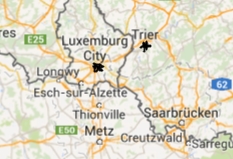Thanks to Felix Chandrakumar, who has processed publicly available Ancient DNA and uploaded it to GEDMatch, it is possible for anyone who has a kit at GEDMatch to compare themselves to DNA dating back 50,000 years ago. These ancient samples have created quite a stir in the genetic genealogy community as when the results became available, not only did it become clear that the ancient samples were matching modern testers, they were matching them in what appeared to be a genealogical time frame.
Obviously, no one who lived 12 thousand years ago is going to have living relatives with a common ancestor is the last 5 generations. So, what on earth was going on? Sample contamination was considered, as was the possibility that the age of the DNA samples themselves was incorrect, and they were in fact much younger. Yet, with ancient sample after ancient sample, modern matches were appearing. Possibly, many of us simply carry similar DNA that has become common to the make up of most humans on the planet.
As a rule of thumb, those who study genetic genealogy consider any match who shares blocks less than 7 centimorgans as being a 30-70 chance of being a true, or Identical By Descent match. However, when studying ancient DNA, the 7 cm. cut off was ignored, as living matches were not expected. GEDMatch offered a tool to test individual kits against all ancient DNA samples, and allows the minimum centimorgan level to be set as low as .5 cm.
My kit matches many of the ancient samples at very low levels. As seen below, each line represents a DNA block the length of 2 centimorgans that I share with each sample, and there is nothing even slightly unusual about that:  What was unusual was that when I raised the centimorgan cut off, Loschbour and I continued to match on Chromosome 8:
What was unusual was that when I raised the centimorgan cut off, Loschbour and I continued to match on Chromosome 8:  None of the other ancient samples produced anything like a similar result for me. Upon further investigation, I discovered Loschbour had other modern matches, with the highest match coming in at 11.2 cm. So who was this ancient man and why was my DNA matching his?
None of the other ancient samples produced anything like a similar result for me. Upon further investigation, I discovered Loschbour had other modern matches, with the highest match coming in at 11.2 cm. So who was this ancient man and why was my DNA matching his?
I checked Loschbour and discovered he was an, “8,000 year old skeleton from the Loschbour rock shelter in Heffingen, Luxembourg.” Luxembourg is an area I’m familiar with, so I was delighted. Both sides of my family have ties to the same general area. As my dad has also tested and has a kit at Gedmatch, I was able to compare him. He did have a single 4 cm match to Loschbour, but had no match to any of the ancient samples beyond that point. Most importantly, his 4 cm match wasn’t on Chromosome 8, but rather on Chromosome 2. Meanwhile, my maternal line descends from the immigrant Margaretha Toemmes, born in 1815, whose family lived in the village of Trassem (Trier) for more than 500 years. Trassem is only 43 kilometers from Heffingen,where the skeleton was found.  Families that have lived in Trassem for centuries, like any other small village in Europe have intermarried repeatedly and mine is no different. I have had no problem confirming this family line back to my 4th great grandparents, Johann Temmes and Maria Schmidt, as descendents essentially carry a ‘double dose’ of DNA thanks to cousin marriages and matches are easily spotted. Given our relatively close cousin-ship with Loschbour, it appears those cousin marriages may have stretched much further back in time than we realized.
Families that have lived in Trassem for centuries, like any other small village in Europe have intermarried repeatedly and mine is no different. I have had no problem confirming this family line back to my 4th great grandparents, Johann Temmes and Maria Schmidt, as descendents essentially carry a ‘double dose’ of DNA thanks to cousin marriages and matches are easily spotted. Given our relatively close cousin-ship with Loschbour, it appears those cousin marriages may have stretched much further back in time than we realized.

Mary Toemmes Lebold
Examining the picture of Mary Toemmes Lebold (the daughter of Johann and Maria Schmitt Temmes), we never thought her to look particularly Germanic and I’ve often wondered what the story was with the ancestor that gave her features such a distinctive cast. Originally, when cousin Bernhard helped me dive into the Church Records, I wouldn’t have batted an eye to find a Hun or Tatar in the family tree, given Mary’s looks. Instead, I found centuries worth of generations all carefully documented in the same little village. Cousin Bernhard had no explanation for Mary’s appearance, either, other than that Germany had been a crossroads since ancient times.
So, what does ancient DNA have to do with Iowa or Iowan DNA? More than you might guess, if your family is anything like mine and you have ancestors that spent generation after generation in the same locality, and then eventually immigrated to America. My Toemmes family arrived just in time to fight in the Civil War, first living in Marshall, Illinois and then moving on to Iowa, where my grandfather James Wise raised his family. Given the number of ancient DNA samples available, with more being added, you might also get a surprisingly substantial match that agrees with your paper trail.
Thanks for your support of sciencesprings. I appreciate it very mcuh.
LikeLiked by 1 person
Hi Cousin, Just came across your blog post. I’m a descendant of Catherine Toemmes, Margaretha’s younger sister. So we share third great-grandparents, making us fourth cousins. I’d love to see more about the research you’ve done in Trassem.
Kevin Huigens
LikeLiked by 1 person
Hi Kevin,
Good to hear from you. There is another Toemmes descendent in the Iowa DNA Project. He descends from the only Toemmes sibling who stayed in Germany (Johann). We’re making progress!
LikeLike
I have family that came from the area along the border of Trier (Sost, Nittle) & Luxembourg areas. I did the 1:1 match as you noted above and also match with Loschbour >6cM’s. I also matched on Chromosome 8: 71045914-74275315 for 6.3 cM’s and SNP’s total of 803.
LikeLiked by 1 person
Very interesting! If your family is like mine there was a lot of intermarriage.
LikeLike
Thanks for a marvelous posting! I truly enjoyed reading it, you may be a great author.I will remember to bookmark your blog and may come back down the road.
I want to encourage that you continue your great writing, have a nice evening!
LikeLike